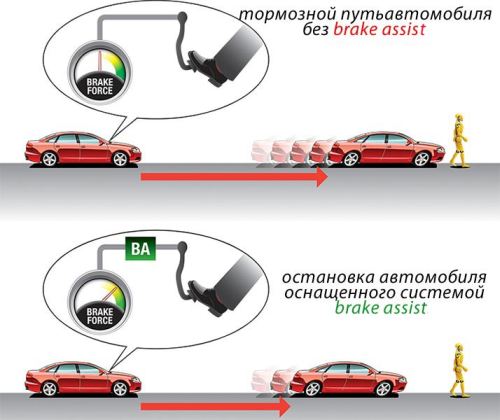
Brake Assist - what is it in a car and what is it for?
To ensure maximum safety for drivers, passengers and pedestrians, car manufacturers install various assistance systems on their products that greatly facilitate the driving process.
One of these systems is the brake assistant or Brake Assist System. In the description for the configuration of a particular model, it is referred to as BAS or BA. It began to be installed since the mid-1990s on Mercedes cars. Later this initiative was picked up by Volvo and BMW.
BAS is available on many other car brands, just under different names:
- EBA (Emergency Brake Assist) - on Japanese cars, in particular Toyota;
- AFU - French cars Citroen, Peugeot, Renault;
- NVV (Hydraulic Brake Booster) - Volkswagen, Audi, Skoda.
It is worth saying that such systems are installed on those cars where there is an anti-lock braking system (ABS), and in the case of French cars, AFU performs two functions:
- vacuum brake pedal booster - analogue of BAS;
- the distribution of braking force on the wheels is an analogue of EBD.
Let's figure out in this article on Vodi.su how the brake assistant works and what benefits the driver gets from using it.

Principle of operation and purpose
Emergency Brake Assist (BAS) is a sophisticated electronic system that helps the driver stop the vehicle during hard braking. Numerous studies and tests have shown that in emergency situations, the driver abruptly presses the brake pedal, while not applying enough force to stop the car as quickly as possible. As a result, the stopping distance is too long and collisions cannot be avoided.
The Brake Assist electronic unit, based on data from the brake pedal sensor and other sensors, recognizes such emergency situations and “presses” the pedal, increasing the pressure of the brake fluid in the system.
For example, on Mercedes cars, the assistant turns on only if the speed of the brake pedal rod exceeds 9 cm / s, while ABS is turned on, the wheels and steering wheel are not completely blocked, so the driver gets the opportunity to avoid skidding, and the stopping distance becomes shorter - we have already talked on Vodi.su about the length of the braking distance and how it is affected by the presence of anti-lock.
That is, the direct function of Brake Assist is interaction with the brake booster and increasing the pressure in the system in case of emergency. The actuating device of the brake assistant is an electric magnet for the rod drive - an impulse is applied to it, as a result of which the pedal is literally pressed into the floor.

If we talk about the French counterpart - AFU, then the same principle is implemented here - emergency situations are recognized by the speed of pressing the brake. In this case, AFU is a vacuum system and interacts with the vacuum brake booster. In addition, if the car begins to skid, the AFU performs the function of electronic brake force distribution (EBD), by locking or unlocking individual wheels.
It is clear that any manufacturer is trying to significantly expand the capabilities of their cars, so many new models have variations on the theme of the brake assistant. For example, on the same Mercedes, they began to install the SBC (Sensotronic Brake Control) system, which performs several functions at once:
- distribution of braking forces on each wheel;
- analyzes the traffic situation;
- calculates emergency moments, analyzing not only the speed of pressing the brake pedal, but also the speed of transferring the driver's foot from the gas pedal to the brake;
- pressure increase in the brake system.
Loading…

